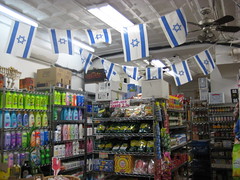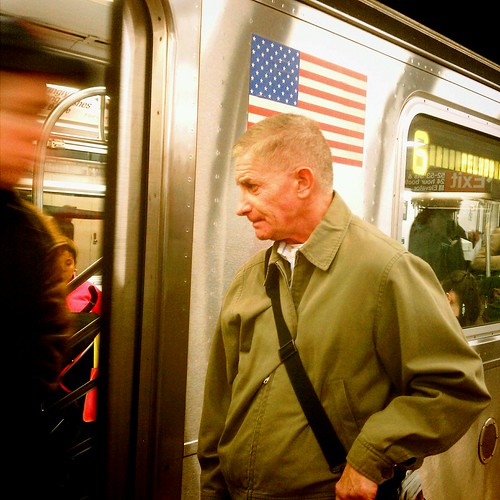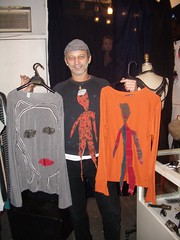 Allison Hertzberg Geová Rodrigues.
Allison Hertzberg Geová Rodrigues.Geová Rodrigues is a Brazilian fashion designer who opened his East Village shop, Geová Atelier, in 2001. After working as a painter in San Paolo, Geová came to New York City in 1992 and launched his first collection in 1998. Trading in his paint brush for fabric, needles, thread and tons of sequins, Geová’s designs have been featured in New York’s Fashion Week and in editorials worldwide.
Vivacious is the first word that comes to mind when trying to describe the designer. He’s effusive and talks to you like you’ve been friends for years. The same energy runs through his bright little shop located at 208 Avenue B. I recently sat down with Geová to better understand who he designs for, why he chose the East Village and how come grown men still play
with dolls.
Q.
Why did you choose the East Village as the place to open your shop?
A.
I love the East Village. I can get very inspired here. It’s a neighborhood with a great attitude. I love how the East Village embodies the same aesthetic as my clothing – a mixture of fabrics, textures and designs that come together to create something beautiful – just like the mix of languages, cultures and creative people that live in the East Village and make it the unique and interesting neighborhood that it is. Also, my first fashion show was in the East Village.
Read more…
Theresa Byrnes has been living in New York City since 2000, showing her art since age 16, and a rebel for as long as she can remember. “I have always valued being challenged more than being happy. Approval seems so stagnant and unexamined,” she wrote in her most recent blog post. And “I am not nice,” she said on her Twitter page, where she goes by the handle feistysparrow.
Ms. Byrnes is a portrait, abstract and performance artist in the East Village. Together, her three forms of expression make up what she calls her “holy trinity,” encompassing the body, mind and soul. The Australian-born Ms. Byrnes uses a wheelchair because of a degenerative nerve disease called Friedrich’s Ataxia. And yet Ms. Byrnes lives and creates with a distinct grace, fearless in her life as well as in her art.
“There is no forever,” she said recently in her East Ninth Street studio, wearing a paint-splattered smock and surrounded by works-in-progress. “It’s a bit boring to me, talking about identity and disability because my life is so beyond that. I’ve left all that way in the past.”
As for the way she sees life, Ms. Byrnes is firm. “There is nothing to fear, except your own illusion of identity,” she said. “Don’t protect yourself – reinvent. Break down the wall.”
NYU Journalism’s Robyn Baitcher reports.
The corner bodega serves as the perfect pit stop for milk, eggs, bread, and, O.K., cigarettes. Beyond the staples, several East Village stores stock basics and treats in international flavors for gastro-curious locals as well as expats in search of a taste of home.
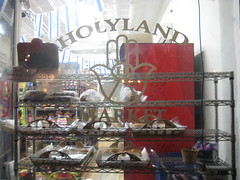 Carolyn Stanley Holyland Market, 122 St. Marks Place.
Carolyn Stanley Holyland Market, 122 St. Marks Place.Holyland Market
122 St. Marks Place
Holyland Market packs its modest space with dozens of Israeli goods. One popular item is Krembo, an air-light marshmallow fluff candy coated in chocolate. “Every kid in Israel grows up eating these,” says Omri Rosen, an employee of the store. The front shelves are filled with all manner of snacks, sweets and cookies, including Bamba — Cheetos-like peanut puffs—and specialty halvah in flavors like pistachio and coffee. Other Hebrew-labeled goods include jarred pickles and olives, couscous, and even cleaning products like sponges and mops. In addition to dry goods, Holyland carries fresh-baked burekas, savory pastries filled with mushroom, spinach or cheese.
A few unexpected items evoke a nostalgic response. “People get so excited when they see we carry OCB cigarette papers,” says Mr. Rosen. And Tim Tams, an Australian-brand cookie that’s very popular in Israel, has devotees from all over. Other than at the Tuck Shop, an Aussie cafe across St. Marks, the hollow, chocolate-coated treats are difficult to find, short of ordering them on eBay. “A couple of girls came in here yesterday and left with maybe seven boxes each,” Mr. Rosen says.
Read more…
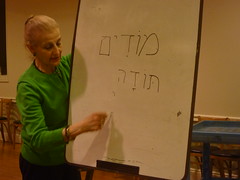 Hannah Rubenstein Carol Green, a religious instructor at the Town and Village Synagogue, teaches Hebrew to a group of adult bat mitzvah students. Although becoming a bar or bat mitzvah as an adult is hardly novel, the synagogue’s program is distinct because its participants undergo the ceremony as a group rather than independently.
Hannah Rubenstein Carol Green, a religious instructor at the Town and Village Synagogue, teaches Hebrew to a group of adult bat mitzvah students. Although becoming a bar or bat mitzvah as an adult is hardly novel, the synagogue’s program is distinct because its participants undergo the ceremony as a group rather than independently.In the basement of the synagogue on a windy Monday evening, a group of students hunch over prayer books, tracing ancient words from right to left with the tips of their fingers. At the end of the table, a woman stands at a whiteboard, writing large letters in careful, deliberate strokes. Because this is a beginning Hebrew class, the progress is halting. But the students are focused. No one glances around the room or shifts in her seat. Together, slowly, their voices chant:
“Baruch atah Adonai… elohaynu melech ha’olam… asher kidshanu… bemitzvotav vetzivanu… l’hadlik ner… shel Shabbat.”
After the last syllable fades away, the teacher breaks into a wide smile. At this rate, the students will surely be ready when the time comes to stand at the bimah and read the Torah in front of the whole congregation. Years of study have prepared them to become bat mitzvahs, to be recognized and welcomed into the Jewish faith as independent adults.
There is only one difference between these students and others around the world studying to become bar and bat mitzvahs — these are not boys and girls, nervously approaching their 13th and 12th birthdays, respectively. These are women between the ages of 20 and 80. This bat mitzvah class is for adults only.
Read more…
 Phillip Kalantzis Cope
Phillip Kalantzis Cope‘Tis the season and we at The Local would like to hear your favorite memories about spending the holidays in the neighborhood.
In a place as distinct and atypical as the East Village, we’re sure that our readers have more than their share of holiday stories that are humorous or poignant, sad or bittersweet or even a little bawdy (within the bounds of good taste, of course) – and we’d like to hear them.
If you want to share your favorite holiday memory, e-mail us your stories in 400 words or less until Dec. 24 and we’ll publish some of the best ones.
When the temperature turns arctic, outerwear is the best way to show off your personal style. On a recent frigid morning, The Local braved the elements to check out how East Villagers are bundling up this season. Classic double-breasted coats and perenially popular down jackets were seen on every corner, but quirky residents donned everything from a houndstooth tweed coat and a plush faux-fur vest to an animal print trench and a trendy army jacket.
NYU Journalism’s Sophie Hoeller and Sally Lauckner take a look at the neighborhood’s most distinctive winterwear.
Nicolina Marie is one of those fortunate East Villagers who are able to make a living with their art.
This holiday season, she is decorating 40 city stores with snowflakes and sleighs throughout the city. On Tuesday at The Bean, a coffee house on Third Street and First Avenue, she painted overnight and into the next day, when customers came in for their morning coffees.
Ms. Marie considers her work at The Bean, B-Cup Cafe, and Two Boots, among others, a commercial form of public art. “I get paid, which is great,” she said. “But I also get to reach a lot of people, which is ideal.”
Ms. Marie has also done projects worldwide, and this December’s sparkly windows are the last of her work before she heads to Chile to complete a public art piece.
She also runs a non-profit group, The Free Art Society, through which she creates public art with her friends. A Seattle native who’s lived in New York for the past four years, Ms. Marie is already well known in the neighborhood, and in November her Free Art Society hosted an Art Explosion of free outdoor art.
NYU Journalism’s Meredith Hoffman reports.
 Gloria Chung Curry-Ya, 214 East 10th Street.
Gloria Chung Curry-Ya, 214 East 10th Street.I don’t like Japanese food. What’s worse, I suspect that I like not liking Japanese food.
Still, here I am in a neighborhood rife with Japanese restaurants, grocery stores, sake bars and, at least in the evenings, young people. In jaunts along East 10th Street between Second and First Avenue, I had often noticed a string of Japanese restaurants along the south side. I had a dim recollection that one of them included in its name a word with which I had positive food associations. When I returned to the block last week, there it was — Curry-Ya (214 East 10th Street). I adore Indian food. Maybe this would be Indo-Japanese.
Curry-Ya is a brightly lit, scrupulously neat place with a counter and a dozen or so wooden stools. I asked the young woman behind the counter if the curry was like Indian curry. She wasn’t sure. “Indian curry is like soup, yes?” Sort of, I said. She suggested we order the Berkshire Pork Cutlet Curry, which was everybody’s favorite. We did. A breaded pork chop, along with a beautifully mounded hillock of rice, came with a gravy boat. This was the curry. I would have called it gravy, though I recognize that I might not have walked into a restaurant called Gravy-Ya.
Read more…
Marlis Momber, a German-born photographer, has documented the dramatic evolution of Loisaida, her home, for decades.
South of 14th Street and north of Houston, east of Avenue A to the East River, Loisaida is all but unknown to some late-coming East Villagers. Though time and gentrification have transformed the neighborhood, Loisaida’s streets still reflect its distinct culture and history.
Many of the murals that are a signature of Ms. Momber’s photographs have faded, but her body of work helps explain the Loisaida we see today.
During a walk through Loisaida, Ms. Momber describes a community that is more than a sign tacked onto Avenue C; Loisaida — a community, a culture, a past not forgotten.
NYU Journalism’s Molly O’Toole reports.
The Space At Tompkins is a recently formed organization designed to work with transient and homeless individuals who hang out in Tompkins Square Park.
The goal is to link people to services they request — food, clothing, a phone call home, clean syringes, access to shelters, help finding a job and information about drug rehabilitation programs. Many of the group’s members are too old to receive help at youth-based organizations but don’t feel comfortable at agencies tailored to adults, according to Andrea Stella, the executive director of The Space At Tompkins. Ms. Stella said her organization’s programs are not age-based.
NYU Journalism’s Liz Wagner reports.
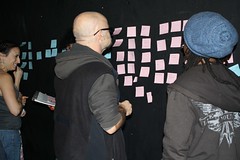 Maya Millett A group of artists gather at East Fourth Street’s WOW Cafe Theater and study the “Haves” and “Needs” wall they created at a networking event hosted by bartering website OurGoods.org. Bartering has enjoyed a resurgence in the neighborhood in the wake of the recession.
Maya Millett A group of artists gather at East Fourth Street’s WOW Cafe Theater and study the “Haves” and “Needs” wall they created at a networking event hosted by bartering website OurGoods.org. Bartering has enjoyed a resurgence in the neighborhood in the wake of the recession.The concept of bartering often conjures an aura of myth: Jack’s storied magic beans, as it turned out after all, was a pretty fortuitous trade for the cow he handed over to the butcher in exchange.
In the wake of the recession, bartering has captured a renewed interest among the cash-strapped or habitually thrifty. In its most recent incarnation, bartering thrives on the Internet. Craigslist, that great Wild West of an online forum, is a barterer’s goldmine. And niche websites like Swap Tree, Neighborgoods, ThingHeap, and countless others are tailored to specific trade interests like tools, books, electronics, furniture and other miscellany.
While the web has ushered bartering into a new era of resource exchange, in artistic communities like the East Village, swapping creative work or services has long been an inherent part of the culture.
“Probably everyone in the low-budget artist class in the East Village has bartered,” says Ayun Halliday, an author and Bust magazine columnist who in 1996 created the cult-coveted “East Village Inky” zine, which chronicles her adventures in motherhood.
Though Ms. Halliday and her family moved to Boerum Hill in 2000, she’s still entrenched in the East Village’s creative scene. Zine publishers, she says, are some of bartering’s most famous traders. Zine making “is definitely a labor of love — and barterers are often purveyors of that.”
Read more…
You know what they say – it’s all about location, location, location. Why worry about where to go on a first date, when you should be worrying about what to wear? Here’s a list of the best first date bars in the East Village that won’t disappoint, just in case the person you’re meeting there does.
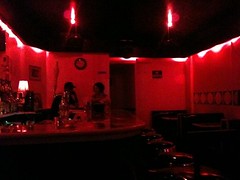 Allison Hertzberg Big Bar, 73 East Seventh Street.
Allison Hertzberg Big Bar, 73 East Seventh Street.Big Bar
73 East Seventh Street, 212-777-6969
This bar is tiny, and reminds me of an 80’s disco – only one that’s been shrunk down to the size of an East Village studio apartment. It never gets too busy at Big Bar, and most nights you can occupy one of their four booths for hours.
Read more…
Timothy Krause on taking portraits of subway riders.
“I’ve been shooting subway pictures with a camera app for my smartphone. I love the intimacy that this affords, as smartphones are near-ubiquitous these days, and few seem to notice one more person playing with one on the subway.”
Read more…
 Anthony Rhoades Anthony Donovan.
Anthony Rhoades Anthony Donovan.For a man who says he isn’t religious, Anthony Donovan sure does spend a lot of time in churches. “I love entering these creative, beautiful spaces,” said Mr. Donovan. “I love the art.”
Mr. Donovan is the facilitator of Local Faith Communities, an ecumenical consortium of a dozen East Village religious leaders – from Buddhist, Hindu, Muslim, Catholic, Jewish, Russian Orthodox traditions among others – that meets periodically to discuss issues facing their congregations and how they can work together to solve them.
On Tuesday evening, the group will host Spiritual Sounds, a free concert featuring music from different religious traditions, at 7 p.m. at the Catholic Church of the Most Holy Redeemer on East Third Street.
Mr. Donovan, who is 58 and has lived in the East Village since 1990, has no formal religious training yet believes strongly in the importance of people finding their common bonds through divergent faiths. His hair is more salt than pepper, and he speaks and listens with the measured calmness of a therapist. He recently sat down with The Local to talk about Local Faith Communities and how living in the East Village has informed his work.
Q.
Why did you start Local Faith Communities?
A.
This all started because I’m tired of what goes on in the name of religion — the hate crimes that are happening in the world because of religion, the wars in the name of religion. Religion seems to be a very easy way to mobilize people for or against something.
Read more…
At 155 Avenue C, a seemingly ordinary five-floor walkup bears an unusual handmade sign: “This Land Is Ours. See Co-Op Squat. Not For Sale.”
This is See Squat, one of 11 remaining squatters’ buildings in the East Village. Now technically a co-op, the building has retained its character as, in the words of one resident, “the countercultural squat.”
Many of the residents at See Squat view one another as a family that has come together from varied pasts – including drug addiction and homelessness – to build and maintain a community on Avenue C with their own hands.
NYU Journalism’s Robyn Baitcher reports.
Inspired and framed by the opening monologue of Woody Allen’s
“Manhattan,” Phillip Kalantzis Cope tells an East Village story through his images and Mr. Allen’s words.
Read more…
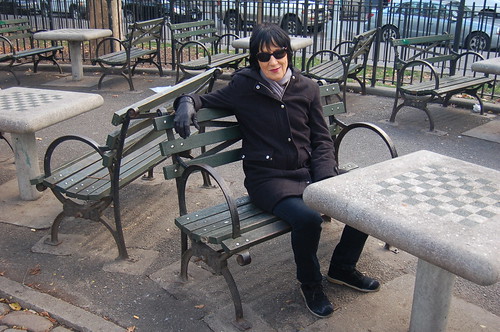 Nathaniel Page Carole Pope.
Nathaniel Page Carole Pope.Carole Pope was lead singer of the Toronto New Wave rock band Rough Trade in the 1970’s and early 1980’s. In 2008, Ms. Pope moved to the East Village, where she is recording a new solo album, due out early next year.
After releasing their album “Avoid Freud” in 1980, Rough Trade traveled from Toronto to perform in New York City. Ms. Pope loved the edginess of the East Village 30 years ago. Now that she lives here, the noise makes her edgy.
“I just want to kill all the Carrie Bradshaw wannabees,” she said. “They don’t know how to hold their liquor. We did.”
In the spring, Ms. Pope is scheduled to be honored with an OutMusic Award, for a career in which she has been cited as an influence by such artists as k.d. lang and Divine. And Ms. Pope is scheduled to perform Saturday at the Brooklyn Museum.
Ms. Pope recently met with The Local at Vandaag on Third Avenue and Sixth Street. When a worker started pounding on the wall above the front door to the restaurant, Ms. Pope jumped and said “Sounds like my place.”
“If I was rich I’d definitely move to the West Village,” she added.
Read more…
 Colleen Leung The author at the end of the East River esplanade construction project just south of Delancy Street. The project is expected to be completed in July.
Colleen Leung The author at the end of the East River esplanade construction project just south of Delancy Street. The project is expected to be completed in July.The East River Waterfront Esplanade and Piers Project was conceived in 2002 as part of Mayor Bloomberg’s “Vision for Lower Manhattan,” yet almost 10 years later, the plan to extend the esplanade from East River Park down to the Battery Maritime Building on the southern tip of the city, creating attractive open space and exercise opportunities for East Village and Lower East Side residents, has not made much progress.
With estimated completion dates that continually get pushed back, the completion of the East River Waterfront Esplanade sometimes seems like a mere pipe dream.
The mayor’s plan promised new bike paths, more seating areas and even a dog run along the water. Yet during a recent excursion to East River Park, I instead noticed a sign with a new projected completion date: July 2011.
According to the official government Web site, Phase I of the the project was scheduled for completion in fall 2010. However, sticking the small piece of paper on the sign over the old scheduled completion date seems to be the only work that has actually gotten done lately.
I proceeded to walk alongside the torn-up rubble next to the water for over a mile, hoping to possibly speak to some workers about the project, but there wasn’t even anyone there.
Perhaps one day the mayor’s plan will allow runners and cyclists to go all the way around lower Manhattan along the east side without taking a detour around the construction. Until then, I’ll get my exercise doing scaffold pull-ups and running back and forth on the small section of Esplanade that ends just South of Delancey Street.
Al Kavadlo is a personal trainer, freelance writer and author of the book, “We’re Working Out! A Zen Approach to Everyday Fitness” (Muscle-up Publications, 2010). For more information visit www.AlKavadlo.com.
In years past, John Lesko led a frenetic, nomadic lifestyle. The 60-year-old native New Yorker — originally from Hell’s Kitchen — has had, in his own words, “a million different jobs.” Mr. Lesko has worked as a machinist, marine, Greyhound bus driver, cabbie, and real estate agent.
But despite this unpredictable career path, his passion for the written word has remained a constant. For the last four decades, his “thrust has been the poetry.” Mr. Lesko, who writes under the pseudonym, Giron d’Agate, draws inspiration from historical events and figures, as well as personal experiences. He currently self-publishes more recent works on his blog.
NYU Journalism’s Sarah Tung reports.
In a neighborhood where everything is changing, Ray’s Candy Store remains refreshingly unchanged. Faded posters line the walls, many of which depict smiling teenage girls in 80’s headbands enjoying Lime Rickeys. Since buying the shop in 1976, Ray Alvarez and his candy store have become fixtures in the East Village.
“Ray’s is the last real thing left in this neighborhood,” said Clemente Valguarnera, owner of the nearby Café Pick Me Up.
This sentiment is echoed by most of Ray’s patrons. That is why the community joined together to raise money when Alvarez began having problems making rent payments.
Open 24 hours a day, Ray’s is the late night gathering place for local regulars, bar-hopping visitors and those who just like the consistency of the frozen yogurt.
NYU Journalism’s Alexandra DiPalma reports.





